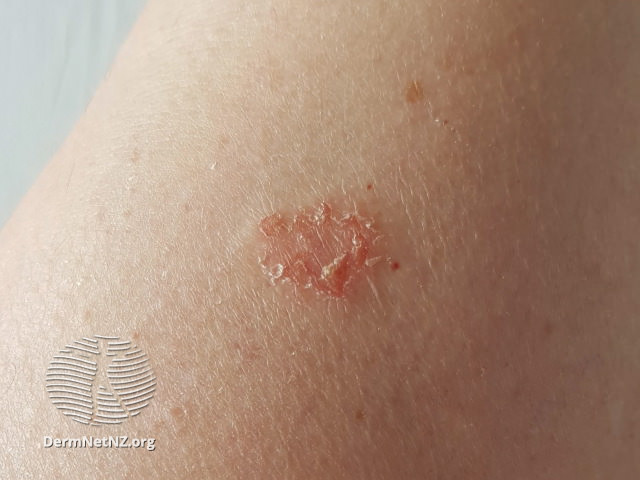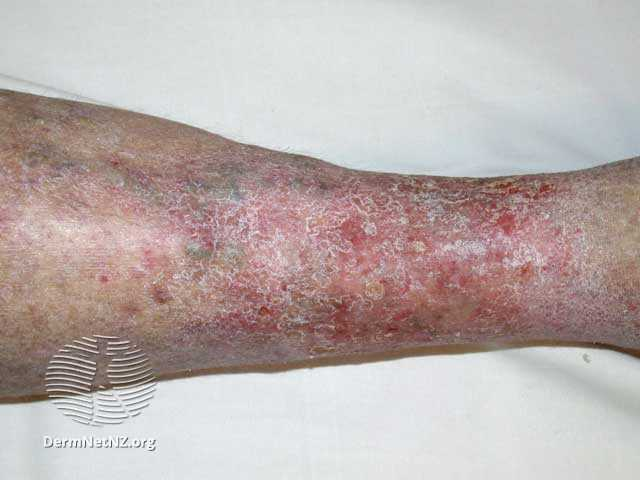Eczema
- dermsoc5
- Mar 27, 2024
- 5 min read
Types of eczema
Eczema, also known as dermatitis, refers to a group of conditions that cause inflammation of the skin. There are several types of eczema, each with its own distinct characteristics. Here are some of the most common types: (1)
Figure 1: Dry atopic dermatitis in an extensor pattern, DermNet (3)
Atopic dermatitis: This is the most common form of eczema, often appearing in early childhood and typically associated with a family history of allergic conditions such as asthma or hay fever. Symptoms include dry, itchy skin, redness, and inflammation.
Figure 2: Allergic Contact Dermatitis - Watch Strap Reaction, DermNet (4)
Contact dermatitis: This type of eczema occurs when the skin comes into contact with irritants or allergens, leading to redness, itching, and sometimes blistering. There are two subtypes:
Irritant contact dermatitis: Caused by contact with substances that irritate the skin, such as detergents, soaps, or cleaning products.
Allergic contact dermatitis: Triggered by an allergic reaction to a specific substance, such as nickel, latex, or certain cosmetics.

Figure 3: Discoid Eczema, DermNet (5)
Discoid/Nummular eczema: Characterized by coin-shaped patches of irritated skin that may be itchy, scaly, and crusty. The cause of nummular eczema is not entirely understood but may be linked to dry skin, injury to the skin, or sensitivity to certain substances.
Seborrheic dermatitis: Commonly known as dandruff when it affects the scalp, seborrheic dermatitis can also occur on other parts of the body, such as the face (especially around the eyebrows, nose, and ears) and the upper chest. It causes redness, greasy-looking skin, and yellow or white scales.
Figure 4: Discrete vesicles and blisters on the palmar skin, DermNet (6)
Dyshidrotic eczema/pompholyx: This type of eczema is characterized by small, itchy blisters that typically develop on the hands and feet. The blisters may be filled with fluid and can cause discomfort and pain.
Figure 5: Venous Eczema, DermNet (7)
Stasis dermatitis: Also known as gravitational/venous dermatitis, this type of eczema typically affects the lower legs and occurs when there is poor circulation in the veins, leading to swelling, redness, and scaling of the skin.
Neurodermatitis: This form of eczema is characterized by thick, scaly patches of skin that are intensely itchy. It often develops in response to repetitive scratching or rubbing of the skin.
Pathophysiology
The pathophysiology of eczema, also known as atopic dermatitis, is complex and involves a combination of genetic, immunologic, environmental, and skin barrier dysfunction factors. While the exact mechanisms are not fully understood, several key factors contribute to the development and progression of eczema
Research shows there is a genetic component to atopic dermatitis. One common mutation has been observed in the gene Filaggrin, a vital gene for skin cell maturity. This gene is responsible for creating the tough, flat corneocytes that form the outermost protective layer of skin. In a patient with normal skin cells, the corneocytes are tightly packed in an organized manner. A patient with a filaggrin mutation will have a dysfunctional skin barrier due to the haphazard organization of the skin cells. This dysfunction causes a 'leaky' skin barrier allowing water loss and decreased protection from harmful substances allowing irritants and allergens to penetrate teh skin. People with eczema also have reduced numbers of beta-defensins in the skin. Beta-defensins are host defense peptides that are vital for fighting off certain bacteria, viruses, and fungi. A decrease in these peptides leads to increased colonization and infection, especially with staph aureus.
Symptoms
These are some of the primary types of eczema, each with its own distinct characteristics and triggers. They commonly present with a range of symptoms which are similar across all forms of eczema:
Dry, Itchy Skin: One of the hallmark symptoms of eczema is dryness and itching of the skin. This itching can range from mild to severe and may worsen at night or with exposure to certain triggers (dust is a very common trigger!)
Redness and Inflammation: Affected areas of the skin often appear red and inflamed, especially during flare-ups. The skin may also feel warm to the touch.
Rash: Eczema can cause a rash that may appear as patches of red or brownish-gray skin. The rash may be raised, bumpy, or have a rough texture.
Scaly or Cracked Skin: In some cases, eczema can lead to the development of scaly or cracked skin, particularly in areas where the skin is thickened or has been scratched repeatedly.
Oozing or Weeping Blisters: During severe flare-ups, eczema may cause blisters to form on the skin. These blisters can ooze fluid and may crust over as they heal.
Thickened Skin: Chronic eczema can lead to thickening of the skin, known as lichenification. This can cause the skin to become leathery or rough in texture.
Sensitive Skin: Eczema-prone skin tends to be more sensitive and reactive to certain substances or environmental factors. It may sting or burn when exposed to irritants such as soaps, detergents, or harsh chemicals.
Secondary Infections: Scratching the itchy skin associated with eczema can break the skin barrier, increasing the risk of bacterial, viral, or fungal infections. Signs of infection may include increased redness, swelling, warmth, and pus-filled lesions.
Discomfort or Pain: Eczema can cause discomfort or pain, particularly when the skin is inflamed, cracked, or irritated.
Investigations and Differential Diagnosis (1)
Skin scraping to exclude a fungal infection mimicking a dermatitis
Skin swab looking for bacterial or viral superadded infection
Patch testing to identify contact allergens
Light testing if a photosensitive dermatitis is considered
Skin biopsy to exclude mimics of dermatitis
Blood tests — IgE (usually elevated in atopic dermatitis), thyroid function (in some hand dermatitis and asteatotic dermatitis).
Management
Treatment of eczema is managed through a stepped approach, tailoring treatment to the severity of the condition. Eczema can be subdivided in to these categories along with their corresponding treatment options: (9)
Clear — if there is normal skin and no evidence of active eczema.
Mild — if there are areas of dry skin, and infrequent itching (with or without small areas of redness).
To start on emollients and advise regarding frequent and liberal application
Consider a mild topical corticosteroid (hydrocortisone 1%) for affected areas. Treatment to be continued for 48 hours after the flare has been controlled
Moderate — if there are areas of dry skin, frequent itching, and redness (with or without excoriation and localized skin thickening).
To start on emollients and advise regarding frequent and liberal application
Inflamed skin should be given potent topical corticosteroid (betamethasone valerate 0.25%/clobetasone butyrate 0.05%)
Severe — if there are widespread areas of dry skin, incessant itching, and redness (with or without excoriation, extensive skin thickening, bleeding, oozing, cracking, and alteration of pigmentation).
To start on emollients and advise regarding frequent and liberal application
Inflamed skin should be given potent topical corticosteroid (betamethasone valerate 0.25%/clobetasone butyrate 0.05%)
Consider prescribing antihistamines for symptoms of severe itch and sedating antihistamines at night if the itch is causing trouble sleeping
Infected — if eczema is weeping, crusted, or there are pustules, with fever or malaise.
Antibiotics are not routinely offered to individuals suffering from secondary bacterial infection of eczema
If antibiotics are offered, flucloxacillin is the first-line choice and clarithromycin is offered if the person has allergy to penicillin
*NB: Delicate areas of the skin (face and flexures), consider starting with a mild potency topical corticosteroid and increase to moderate potency only if necessary. Aim for a maximum of 5 days' use
Support Group
The National Eczema Society is a self-help organization dedicated to improving the quality of life for people with eczema, other skin diseases, related conditions, and their care providers. The Society also works to identify and seeks to resolve issues that affect the interests of affected individuals; raise awareness about the rights and needs of affected individuals; and campaign actively on behalf of affected individuals. (10)
References
1. Dermatitis [Internet]. Available from: https://dermnetnz.org/topics/dermatitis
2. Eczema: Overview [Internet]. U.S. National Library of Medicine; 2017. Available from: https://www.ncbi.nlm.nih.gov/books/NBK279399/
3. Atopic dermatitis [Internet]. Available from: https://dermnetnz.org/topics/atopic-dermatitis
4. Allergic contact dermatitis [Internet]. Available from: https://dermnetnz.org/topics/allergic-contact-dermatitis
5. Discoid eczema [Internet]. Available from: https://dermnetnz.org/topics/discoid-eczema
6. Dyshidrotic eczema (pompholyx) [Internet]. Available from: https://dermnetnz.org/topics/dyshidrotic-eczema
7. Venous eczema [Internet]. Available from: https://dermnetnz.org/topics/venous-eczema
8. Nemeth V. Eczema [Internet]. U.S. National Library of Medicine; 2022. Available from: https://www.ncbi.nlm.nih.gov/books/NBK538209/
9. CKS is only available in the UK [Internet]. Available from: https://cks.nice.org.uk/topics/eczema-atopic/
10. National Eczema Society UK [Internet]. 2023 [cited 2024 Mar 27]. Available from: https://rarediseases.org/organizations/national-eczema-society-uk/








Comments